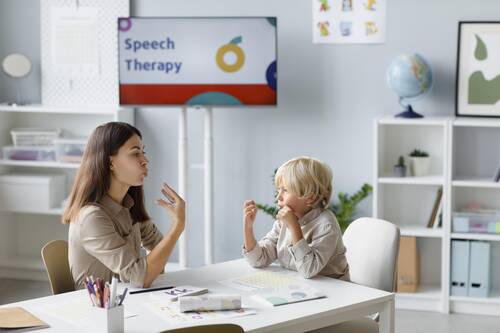
02 Nov Top 5 Technological Innovations in Speech Therapy
Technology has been benefitting the field of speech therapy for ages, but living in the digital age; we have not seen such a jump in innovations that have been helping speech-language pathologists (SLPs), otherwise known as speech therapists, better diagnose and treat patients as we have in the past few years, both in and out of therapy.
In this article, we’ll discuss the cutting-edge technology, from tools to apps, that has been implemented to improve the role of speech therapy.
What are the limitations and challenges faced by speech pathologists?
As with all professions, speech therapists also share a number of limitations and challenges when it providing effective treatment for individuals. While they do make a huge difference in the lives of their patients, here are some of the biggest hurdles that SLPs face in their field:
- Sessions and treatment are time-consuming – speech therapy requires multiple in-person sessions on a weekly basis in order to see results. It’s because of this that many people don’t attend sessions as they don’t have the time or resources to make it to regular sessions.
- It can be difficult to keep individuals engaged – many of the methods used in traditional speech therapy can seem tedious and less engaging. This makes it difficult to motivate individuals to perform, especially when working with young children.
- Limited accessibility – another huge limitation of speech therapy is that it’s not readily available in underserved and rural areas, which means there are a lot of people not receiving treatment purely because there isn’t a speech therapist close by.
What are the biggest technological innovations in speech therapy?
When we focus on limitations that are placed on speech therapy, it becomes obvious that there are a few gaps where technology has been able to come in and remove the glass ceiling. Here are some of the biggest technological innovations that are being utilised for speech therapy and how they’re impacting the field for the better:
1. Online speech therapy sessions
No speech therapist in the area? Thanks to the various online meeting platforms available, people in isolated and underserved areas now have access to speech therapy. They only need a device that has access to the internet, and they can have their pick of speech therapists online. Aside from improved accessibility, teletherapy has also made booking appointments more flexible, cut out the costs of travel and allowed for more consistency.
If you’re looking to make an appointment with a speech therapist in Australia, Hear & Say offers both teletherapy and in-person speech therapy sessions across the country.
2. Virtual reality
While meeting with your speech therapist online is helpful, there’s no denying that it lacks that in-person feeling that makes individuals feel more connected and engaged during their sessions. Virtual reality (VR) is an immersive technology that is changing speech therapy for the better on multiple levels. Using VR applications, SLPs are able to:
- Give their clients exercises targeted at articulation and pronunciation and provide them with auditory and visual feedback in real-time.
- Simulate real-life scenarios so clients can practise their skills in a controlled environment.
- Provide exposure therapy to desensitise clients to their fears, build up their confidence and aid them in overcoming speech-related anxiety and phobias.
3. Apps and games
For speech therapists who treat children, it can be incredibly challenging to hold their attention and engage them throughout sessions. Now, there are various games and apps that have been specifically designed for speech therapy to make sessions and practising outside of sessions more exciting. This boosts motivation and consistency immensely! Some of the most notable apps to check out include:
- Speech Blubs
- Articulation Station
- LAMP Words for Life
4. Speech recognition software
Imagine having a small, friendly assistant with whom you can practice your speech exercises, and it could give you feedback in real-time. Well, there are various speech recognition and analysis software that have been developed to use on your phone and other devices, which listen to what you say and, using algorithms, will break down the speech into its various components to provide you with feedback.
5. AI and data analytics
AI and data analytics are taking the lead in aiding speech therapy, as these tools are able to help speech therapists provide personalised treatment plans, accurately track an individual’s progress in real time, and analyse speech patterns with precision. With the use of AI and data analytics, SLPs have been given the tools to analyse and organise their clients’ treatment plans unlike ever before, as there are aspects of speech and language (like fluency, rhythm and pronunciation errors) that are difficult to pick up on that are now being addressed in-depth.
Final Thoughts
With the advancements in technology, diagnosis and treatment for speech and hearing problems are improving dramatically. As much as these innovations are making the job of a speech pathologist easier, and it might seem like you could treat yourself from home, there will always be a need to see a professional in order to receive proper treatment to see an improvement in your or your child’s condition. So, while they are amazing, the human element in speech therapy will always be needed.
————–
The information on MedicalResearch.com is provided for educational purposes only, and is in no way intended to diagnose, cure, or treat any medical or other condition.
Some links are sponsored. Products and services are not warranted or endorsed.
Always seek the advice of your physician or other qualified health and ask your doctor any questions you may have regarding a medical condition. In addition to all other limitations and disclaimers in this agreement, service provider and its third party providers disclaim any liability or loss in connection with the content provided on this website.
Last Updated on November 2, 2024 by Marie Benz MD FAAD
